A Body in the Studio
Australian artist Tim Silver on why the physicality of time is just as fascinating as its impermanence, and how the dialogue between the two is a potent study in ephemerality
Praveena Shivram
The body lies there, cracked and open to the world. The fissures erupt like an earthquake in slow motion, as we watch the progress of time and decay collide like broken bits of asteroids, changing the landscape of what makes an identity and the inherent burden of impermanence it carries. Tim Silver’s ‘performance objects’, as he calls it, are carefully designed and constructed moulds of the physical body – both the animate and the inanimate – that as installations and photographs are a stark reminder of the fragility of life and its immutable bond to the passage of time, as much as they are arresting visuals of the beauty embedded in eventual destruction.
So it isn’t surprising that Tim’s studio in Redfern, Sydney, looks like an impossible cross between a carpenter’s workstation and a doctor’s autopsy room, where things are built and then broken apart and then built again. ‘As an artist, I work primarily across the casting and photographic mediums, so I don’t necessarily see myself as a creator. I’m more a copier. I take forms that already exist in the world. The scenarios I set up, under which the work unfolds, do carry an element of chance and randomness. Yet, at the same time, these scenarios are incredibly orchestrated. Materials and forms are tested and played out repeatedly in the studio, over and over again. So much so that chance and randomness don’t seem that appropriate descriptions anymore. ‘The outcomes in my work are working within a set of specific parameters. I may not know exactly how things may unfold, but I do know they will unfold within a range of potential outcomes. Perhaps, in this way the work embodies the idea of chance more than the actuality of it,’ he says. But the actuality of chance does exist – in us, the viewer. That as we go about our lives, tiptoeing around the insignificance of form, structure and breath, agonisingly and awe-inspiringly laid bare in front of us through Tim’s work, we are made aware of this thing called chance, elusive like the shadow, fleeting like a memory, formless like a thought, but always there.

Excerpts from the interview
I wanted to start by asking you what image you see when I say ‘time’. Not the passage of time or the impermanence of time, but just the word as is. Immediately, what is the first thing you see?
Having just stepped off a plane from Yinchuan, China, to my home in Sydney, Australia, I cannot think of a response without this experience in mind. Air travel is somehow to be suspended in time, trapped in a pressurised capsule in the sky. Yet, at the same time, one is acutely aware of that same time; as you inch your way minute by minute to your ultimate destination. So when you ask me this question now, I can only respond with a form of non-answer. I see a nothingness; a void; an abyss.
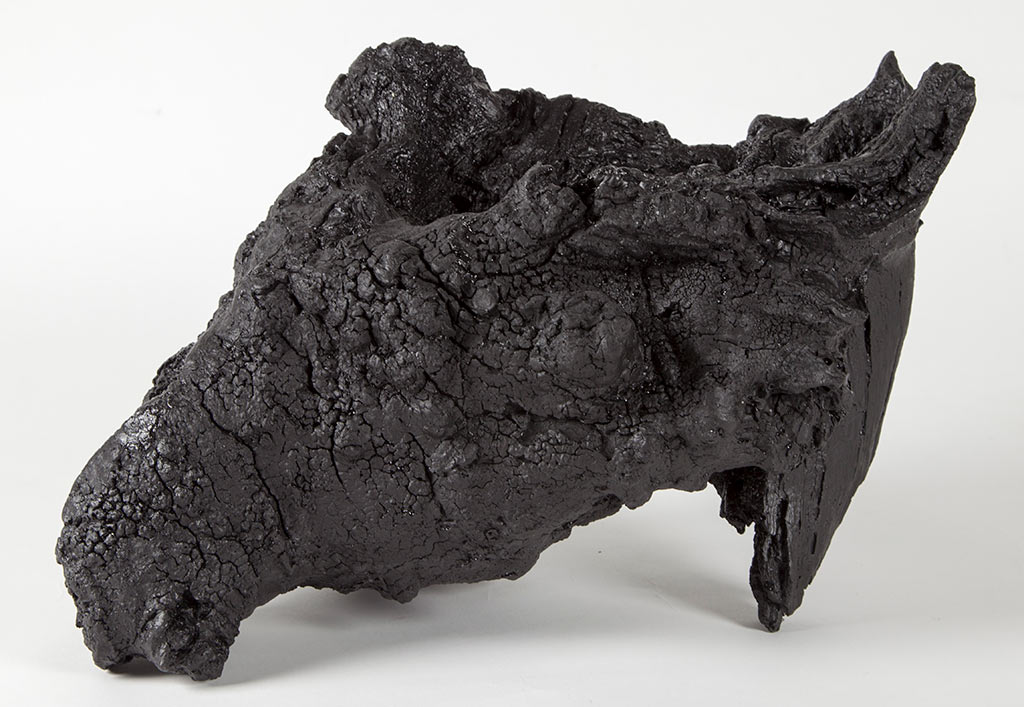
I feel an artist naturally engages with different aspects of time – as memory, dreams, birth, death… and, yet, with your work, it isn’t so much about the ephemeral as much as it is about the physicality of that ephemeral quality of time. It’s as if this concept of time – moving, ageing, dying – is somehow made real and tangible, so that, momentarily (and ironically), I forget about its impermanence and instead just tappreciate its beauty. So my question is, how do you stay one step ahead of this paradox in thought and then take a step back to actually create your work? What happens to you between process and finished product?
Yes. In many ways, I seek to make that material change visible. My working process is similar to a laboratory, where I am playing around with materials and seeing what they can do, how they can assume applications for which they weren’t intended. In this way, though, I am not thinking about a particular outcome when I discover some aspect of materiality. I am focused on the particular aspect of ‘uncovering.’ It is the discovery of the archaeologist. Reflection and examination come after. Whilst art, or more specifically, the art market, demands a resolution, an outcome, a ‘finished product’ as you say, I see these ideas and processes as just one possible iteration of many possibilities.
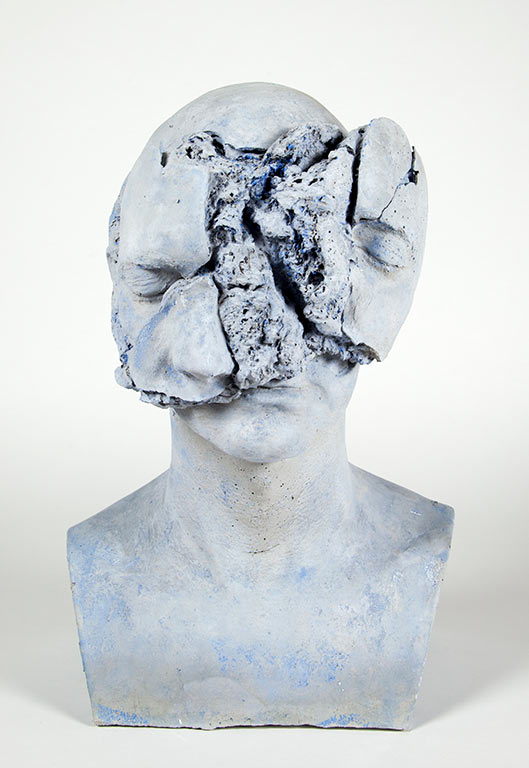
Between the physicality of the human body and the physicality of time, how do you see yourself? As artist-moderator or as artist-co-creator?
Whilst the human form I work with is often myself, I don’t recognise it as such. Perhaps, this is a coping mechanism working in the studio. The form becomes just that, and divorced from my perception as self. Whilst others clearly see it as me, my relationship to it is more of a stand in, an every man. The relationship between the objects I make and their unfolding in the world is definitely one as artist-moderator. I bring things together – forms, materials – and supervise their new juxtaposition in the world.
In ‘Talking to the Shadows’, where you create a bust using the slowest growing pine in the world that is then destroyed (though it is captured on video and therefore, in a way, it actually remains for posterity), what happens to your own idea of time? What I mean here is, does time itself become like a material in your hands, like that pine dust?
I believe the work you mean here is Untitled (blow up) from the exhibition Talking to the Shadows. This was the first substantial video work I have produced. Working with photography and, in particular, working with the sequential nature of photography to reveal a narrative, I find the absences in that narrative are equally as important as the images you actually produce. Like a song of which you have forgotten some of the lyrics, the viewer is invited to fill in the gaps of that narrative. The photographs only suggest what totality is happening at specific intervals. I feel with video, the viewer is witness to everything that is unfolding and that is a very different relationship. When I decided to undertake a video piece, I knew I wanted the transformation occurring to happen instantaneously. As opposed to my other projects that unfold over days or weeks, here it occurs in a matter of seconds, a few seconds, slowed down to a five-minute duration. We become painfully aware of time in this process. We get to observe it. I’m not sure whether time can actually be a material in the same way as the Huon pine dust though. It is not something that I can shape or mould. Perhaps, I can manipulate time’s representation through slowing down the moving image, or only revealing a glimpse of it in the photographic series.
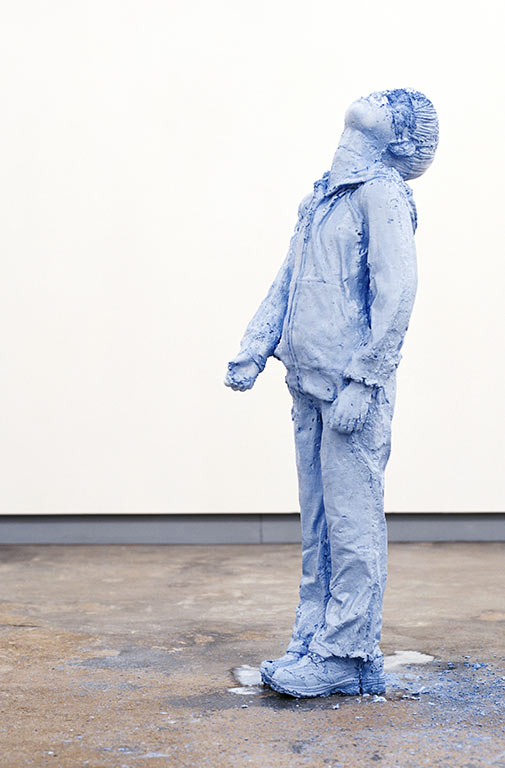
There is the element of the natural, the organic in your work – not in just the materials you use but also in the transformation that you incorporate into your work. Is the idea of time, then, more natural and cyclical in nature for you, than the mechanical idea of time all of us seem to be immersed in? And, if ‘yes’, then how do you position your work within this mechanically constructed uni-dimensional idea of time?
The materials I tend to use in my work are ones that are often malleable. They lend their own qualities to the process of transformation. They have their own lives. Time is something that happens. In that sense it is ‘natural’ rather than mechanical or measured. Yet, in the studio, as these things are played out again and again, time becomes labour. It becomes the repetitive activity of gradually painting a mould with watercolour pigment till it becomes an object. Or baking bread over and over until it permeates the plaster bust in a way I find fascinating. Often it recalls an experience not dissimilar to Harold Ramis’s Groundhog Day starring Bill Murray. The thing is once you give your work up to the world, when you exhibit it to an audience, it is participating in the world like any other object. Time isn’t an abstract, but something that accompanies us. It is the same for the work.
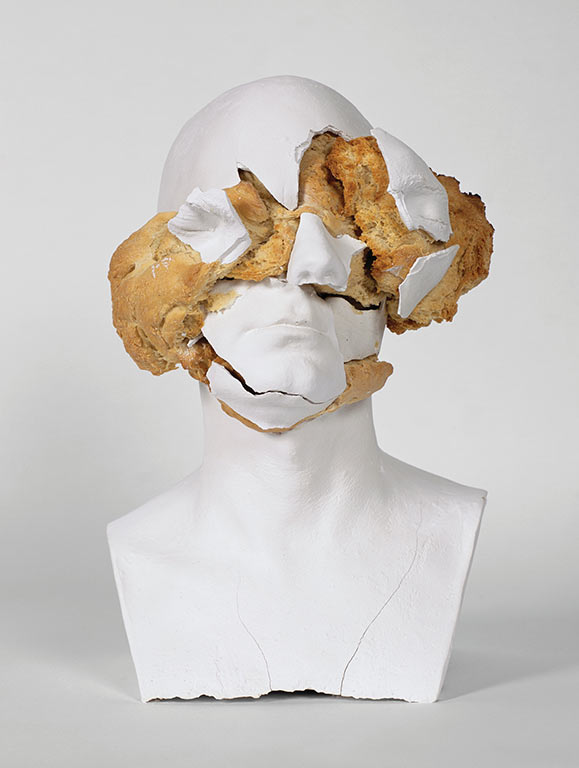
Which brings me to the burls. Here, the transformation has already taken place and you freeze that moment for us to see. It’s almost as if first you show us what happens with change/decay – the process of it, time on the outside – and then we are asked to stop and contemplate this time on the inside through the burls, which is again what trauma does – we go inward. Are you conscious of this process at all? Or is it the fact that you are already in this zone and can naturally see that things may fall apart (in a good way!), but that they also fall into place?
In a catalogue essay, Australian writer Stuart Koop proposed the rhetorical question, like the alchemist, at which point to arrest the process and to what effect. The burls act out this scenario without my involvement, or more precisely, my discovery of them is when their own natural process is arrested. Perhaps, in relation to your first question, I see time as trauma. I’m not sure. I certainly see these burls as sites of trauma. They are an infliction of damage, where the grain of the wood grows against its natural inclination. Once removed from their tree source and cast in black pigmented polyurethane, they become formless – both abstract and representational at the same time. They become the physical manifestation of the trauma of their damage. As an artist, as a maker of exhibitions, I do consider how these things reverberate against each other. There is a consideration, when working with more permanent materials, what these represent, how they are enacted in their stillness, even muteness, against any element which sets out to register time’s relentless movement onwards. There is an intuitiveness to this. So, yes, I would say these things fall into place. They feel right in their juxtapositions.

When you work so extensively with the idea of impermanence of time (and therefore the impermanence of memory), how would you like your work to be remembered?
Ha! I think all artists want to be remembered in whichever small way they can be. It is the point of contributing to the discourse of contemporary art, to add to it, to be visible within it, or even just be acknowledged by it. I think if you wanted to shape the world around you in a more immediate way, there are other fields of endeavour which would be more effective. Art is the trace of our existence. And whilst our collective memories are always shaped in the present, we continually desire to be reimagined in that present. And here I think of Bill Pulman’s character, Fred Madison, in David Lynch’s Lost Highway, who says, ‘I like to remember things in my own way. How I remembered them, not necessarily the way they happened’.
As you grow/change/transform with time, how do you think your own communication through art has changed?
I hope it has become more resolved. At the same time, I hope it hasn’t lost some (or all) of the urgency that comes with youth. Art, in all its forms, is merely a response to the world, a response to a set of circumstances that have and continue to compose us as individuals. If this is where I find myself, art is what I answer back with. It is On Kawara declaring, ‘I am still alive’ (even from his posthumous state).
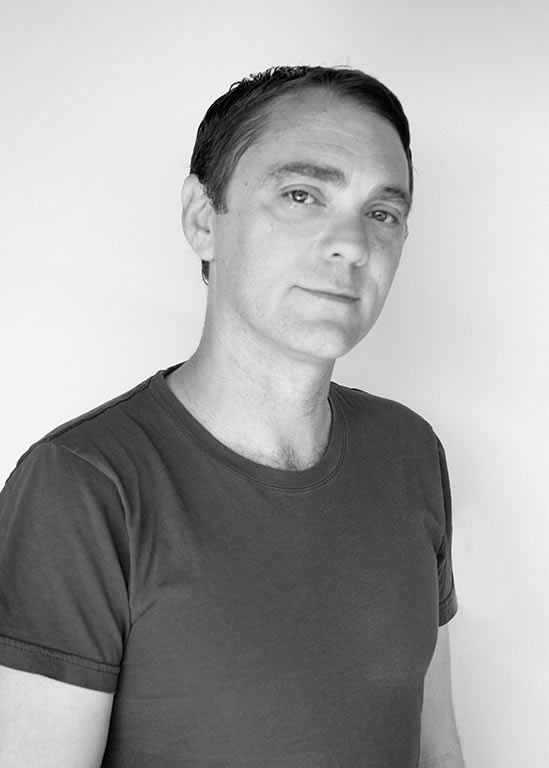
And, finally, what do you think your art resonates with more – the unpredictable nature of time, or the predictable framework within which time functions?
It is both. It is the messiness of these sentiments that offer a degree of authenticity for me. On which day? In which moment? It is this inconclusiveness about my relationship to time that continues to fascinate me. For me, time possesses gravity, the heaviness or burden of the past, which, as I’ve said before, informs our present. And, as you have mentioned, there are moments of beauty and moments of poetics to be found there. Simultaneously, the idea of time, whilst it continues to exist, offers us a world of possibilities. A world of as-yet unrealised outcomes.
__________________________________________________________________________________________________
All images courtesy of Tim Silver and Sullivan + Strumpf
Share